Automatic External Defibrillators (AEDs) in the Workplace
- Jul 16, 2018

Why are AEDs so important in the workplace?
More than 220,000 Americans suffer from cardiac arrest each year. Approximately 10,000 of these sudden cardiac arrests occur in the workplace (OSHA). Even more striking, OSHA reports that waiting for emergency medical personnel to arrive results in only a 5-7% survival while studies with immediate defibrillation have shown up to 60% survival one year after a sudden cardiac arrest.
The Difference Between Sudden Cardiac Arrest and a Heart Attack
As you consider the importance of installing AEDs in your workplace or organization, it’s important to understand the difference between a heart attack and sudden cardiac arrest. Although people often use the terms sudden cardiac arrest and heart attack interchangeably, they are not the same thing.
A heart attack occurs when blood flow to the heart is blocked, preventing oxygenated blood from reaching the heart. Although symptoms may be sudden and severe, more often than not, the symptoms of a heart attack start slowly and usually last for hours, days, or even weeks before a heart attack. Health.com notes that the average age for a first heart attack in men is 66 and 70 for women. Those who are suffering from a heart attack are conscious and their heart is still beating.
Sudden cardiac arrest, on the other hand, happens when the heart stops beating. It often occurs without warning. Sudden cardiac arrest can strike at any age and at any time. Unlike those who are experiencing a heart attack, victims of sudden cardiac arrest are not conscious and their hearts are not beating. In the event of sudden cardiac arrest in the workplace, having an AED on-site may mean the difference between life and death.
The American Heart Association writes that a sudden cardiac arrest is “triggered by an electrical malfunction in the heart that causes an irregular heartbeat (arrhythmia). With its pumping action disrupted, the heart cannot pump blood to the brain, lungs and other organs. Seconds later, a person loses consciousness and has no pulse. Death occurs within minutes if the victim does not receive treatment.” The AHA goes on to note that a heart attack is a circulation problem and a sudden cardiac arrest is an “electrical” problem.
The most common causes of sudden cardiac arrest in the workplace may be safety related, like electrocution or asphyxiation. But they may also stem from employees’ health conditions, too, like heart attack or congenital heart defects.
How Does an AED Work?
AEDs in the workplace save lives by restoring normal heart rhythms in individuals who suffer sudden cardiac arrest. Analysis of the workplace fatalities showed that up to 60 percent might have been saved if AEDs were immediately available and companies were not just relying on EMS (OHS Online).
An AED is a small, portable and user-friendly electronic device that can automatically diagnose and respond to life-threatening heart rhythms. Most AEDs provide simple, easy-to-follow audio and visual instructions that bystanders can quickly comprehend and apply. Some AEDs advise the user when to administer the shock, while other AEDs may automatically apply a shock if the heart is arrhythmic.
On-site AEDs save valuable treatment time and can dramatically improve survival odds because they can be used before emergency medical personnel arrive. Modern AEDs are battery-operated, compact, light, and portable. Because safeguards are programmed into each unit, you do not have to worry about shocking a victim who has a heartbeat, thereby dramatically reducing the risk of doing more harm.
Who Can Use an AED?
AEDs have a proven record of helping save lives in public areas such as airports, community centers, schools, as well as in the workplace. Most AEDs are designed to be used by non-medical personnel. Having more people in your community who are trained to respond to a medical emergency by providing CPR and defibrillation will increase sudden cardiac arrest survival rates.
For more information about purchasing a new or recertified AED or to schedule AED training or maintenance, contact Cardio Partners at 800-544-0004 or email us at customerservice@cardiopartners.com.





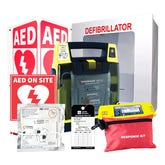
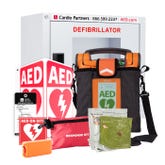
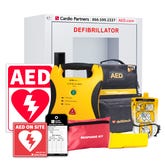
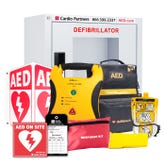
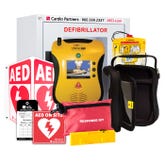
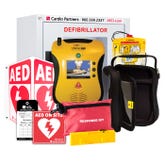
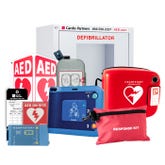
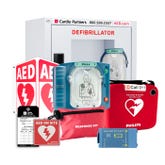
 CALL US:
CALL US: